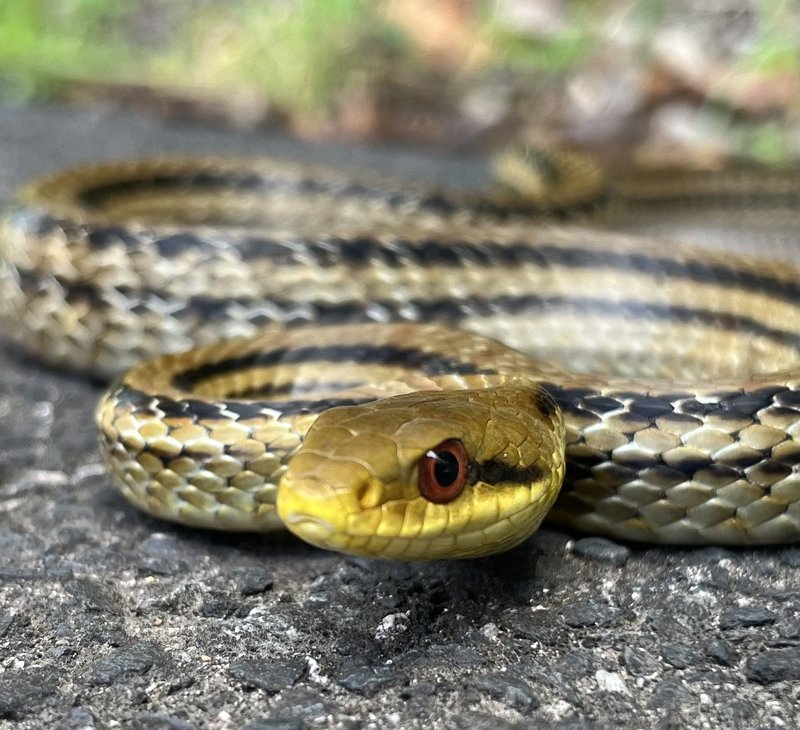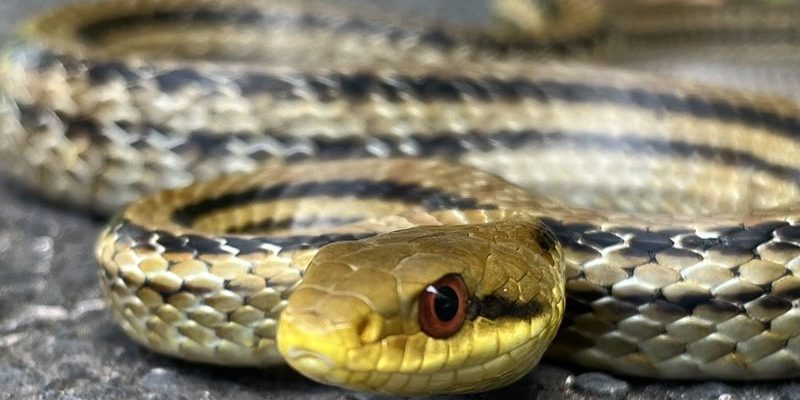
The Japanese Rat Snake, known scientifically as Elaphe climacophora, is a captivating creature that lives in the lush landscapes of Japan. When you first encounter this snake, you might find yourself intrigued by its beautiful patterns and unique behaviors. Imagine a snake that resembles a work of art, with hues of yellow, green, and even black, elegantly gliding through trees or bushes. This snake isn’t just a pretty face; it plays a vital role in the ecosystem and has some intriguing habits that set it apart from its relatives.
If you’re venturing into the world of snakes, the Japanese Rat Snake offers an excellent starting point. With a friendly demeanor and relatively docile nature, these snakes are often kept as pets. They’re not just visually stunning; they also have interesting traits that make them fascinating to observe. Let’s explore everything you need to know about this incredible snake, from its habitat and diet to its behavior and care when kept in captivity.
Physical Characteristics
The Japanese Rat Snake can vary quite a bit in appearance, which makes it all the more fascinating. Typically, they average between 4 to 6 feet long, although some individuals have been known to grow even larger. One of the features that stand out is their color, which can range from a striking bright yellow to a deep forest green. Some populations exhibit a dark phase, where they appear nearly black, providing excellent camouflage in their natural habitat. Their scales are smooth and glossy, adding to their elegance.
Another interesting aspect of their physicality is their eyes. The Japanese Rat Snake has large, expressive eyes with vertical pupils, which give them exceptional vision, especially in low light. This visual acuity helps them hunt during twilight hours. When threatened, they may also flatten their bodies to appear larger or hiss to deter predators, which is quite a sight. Their body shape is slender and elongated, ideal for climbing trees, hunting birds, and navigating through dense vegetation.
Habitat and Distribution
As the name suggests, the Japanese Rat Snake is native to Japan, where it can be found in a variety of environments. They thrive in forests, grasslands, and even urban areas. These adaptable snakes prefer mixed woodlands and can often be spotted basking in the sun on tree branches or rocks. Their preference for warm climates is evident, and they are particularly active during the warmer months of the year.
You’ll find the Japanese Rat Snake primarily on four islands: Honshu, Shikoku, Kyushu, and parts of Okinawa. It’s fascinating to think about how these snakes have learned to navigate and adapt to different regions across the islands. In cities, they are often seen in gardens or parks, demonstrating their ability to coexist with humans. However, they will seek refuge in more rural areas when the human presence becomes overwhelming, showcasing their preference for quieter habitats.
Diet and Hunting Behavior
The diet of the Japanese Rat Snake is quite diverse, primarily consisting of small mammals, birds, and sometimes lizards. They are constrictors, meaning they coil around their prey and squeeze until it can no longer breathe. This method of hunting is both efficient and necessary; they have to subdue their prey quickly to prevent escape. You might be surprised to learn that they can consume prey larger than their own head due to their flexible jaws!
In the wild, they often hunt at dawn and dusk, utilizing their keen eyesight to detect movement. It’s a little like fishing with your eyes, where they need to be attuned to the subtle changes in their surroundings. Once they spot potential prey, they can act quickly, using stealth and speed to catch it off guard. This hunting strategy is not only effective but also crucial in managing the populations of rodents and other small animals, which helps maintain the ecological balance.
Behavior and Temperament
The Japanese Rat Snake is generally known for its calm and docile temperament, making it a popular choice for pet owners. They tend to be curious and active, often exploring their surroundings and climbing when given the opportunity. If you were to observe one in a terrarium, you’d likely see it soaking up heat from a basking lamp or slithering around its enclosure in search of a cozy spot.
When threatened, instead of attacking, they often prefer to retreat or hide. This non-aggressive behavior makes them less likely to bite compared to other snake species. However, if they feel cornered, they may hiss or strike as a warning. It’s essential to handle them gently if you decide to keep one as a pet. Over time, they tend to become accustomed to their owners and can form a bond, enjoying moments of interaction without much stress.
Reproduction and Lifespan
Breeding season for the Japanese Rat Snake typically occurs in the spring. After mating, the females will lay anywhere between 4 to 20 eggs, which they will bury in warm, moist soil or leaf litter. The incubation period lasts about two to three months, during which the mother does not protect her eggs. This is quite different from some other snakes that stay with their young. Instead, hatchlings emerge fully formed and independent, ready to tackle the world on their own.
In terms of lifespan, when kept in optimal conditions, a Japanese Rat Snake can live up to 15 years or longer in captivity. This is quite impressive compared to many other snake species. Proper care includes a balanced diet, a suitable habitat that mimics their natural environment, and regular health check-ups. These factors contribute significantly to their well-being and longevity, allowing snake enthusiasts to enjoy their company for many years.
Table of Key Facts
| Scientific Name: | Elaphe climacophora |
| Average Length: | 4 to 6 feet |
| Habitat: | Forests, grasslands, and urban areas |
| Diet: | Small mammals, birds, and lizards |
| Behavior: | Docile and non-aggressive |
| Reproduction: | 4 to 20 eggs per clutch |
| Lifespan: | Up to 15 years or more in captivity |
Caring for a Japanese Rat Snake as a Pet
If you’re considering bringing a Japanese Rat Snake into your home, you’re in for a delightful experience. First off, it’s crucial to create a suitable environment that mimics their natural habitat. A terrarium with ample space, soft bedding, and climbing structures is essential. Make sure to maintain proper temperatures, as they thrive in warm conditions. Providing a basking area with a heat lamp will keep your snake comfortable and happy.
Feeding your snake is another important aspect of care. As they primarily eat rodents in the wild, a diet consisting of appropriately sized frozen or live mice is ideal. You can establish a feeding schedule that works for you and your snake, typically once every 1-2 weeks for adults. Always ensure fresh water is available, and monitor for any signs of health issues, such as shedding difficulties or changes in behavior.
Handling your Japanese Rat Snake can be one of the most rewarding parts of having one as a pet. Start slowly—allow your snake to get used to your presence. Gradually, you can increase your handling time. Most Japanese Rat Snakes enjoy being out and about, so give them the chance to explore safely when you have supervision. Remember, patience is key, and you’ll develop a great bond with your new companion!
The Japanese Rat Snake is not only a beautiful and fascinating creature, but it also plays a vital role in its ecosystem. Whether you’re admiring their beauty in the wild or considering one as a pet, there’s so much to appreciate about these snakes. Their docile nature, unique behaviors, and the joy they bring to their keepers make them truly special. If you ever get the chance to see one in its natural habitat, take a moment to observe—there’s a whole world just waiting to be discovered!
FAQ
What do Japanese Rat Snakes eat in the wild?
In the wild, Japanese Rat Snakes primarily feed on small mammals, birds, and lizards. Their diet is quite varied, allowing them to adapt to the food sources available in their habitat. They are known to be opportunistic feeders, meaning they might also consume other small animals if the opportunity arises. This adaptability helps them thrive in different environments across Japan.
Are Japanese Rat Snakes good pets?
Yes, Japanese Rat Snakes can make excellent pets! They are generally calm and non-aggressive, which makes them suitable for both beginners and more experienced snake owners. Their relatively simple care requirements and docile nature allow for easy handling and enjoyable interactions. However, like all pets, they require proper care and attention to ensure they remain healthy and happy.
How long do Japanese Rat Snakes live in captivity?
In captivity, Japanese Rat Snakes can live for up to 15 years or more with good care. Providing a balanced diet, appropriate habitat, and regular health check-ups plays a significant role in their lifespan. The rich experiences and interactions you provide can also contribute positively to their well-being.
Do Japanese Rat Snakes need a lot of space?
While Japanese Rat Snakes don’t require an excessively large enclosure, they do need enough space to move around comfortably and climb. A terrarium that is at least 30 gallons is typically adequate for an adult. Make sure to include hiding spots and climbing structures to encourage natural behaviors, which keeps them mentally stimulated and healthy.
Can Japanese Rat Snakes be kept with other snakes?
Generally, it is not advisable to keep multiple snakes together, including Japanese Rat Snakes. While they can be social creatures, housing them together can lead to stress and territorial disputes, which may result in injury or harm to one another. It’s best to keep them in separate enclosures to ensure their safety and well-being.
What temperature should I maintain in the terrarium?
Maintaining the right temperature is essential for a healthy Japanese Rat Snake. The basking area should be around 85-90°F, while the cooler side of the enclosure can be kept between 70-75°F. This temperature gradient allows your snake to regulate its body temperature effectively, mimicking their natural habitat.
How often should I feed my Japanese Rat Snake?
You should feed your Japanese Rat Snake approximately once every 1-2 weeks, depending on its age and size. Hatchlings and young snakes may need to eat more frequently, while adults can have less frequent meals. It’s important to offer appropriately sized rodents, ensuring the prey is not larger than the widest part of your snake’s body.
Are there any common health issues with Japanese Rat Snakes?
Japanese Rat Snakes are generally hardy, but like all pets, they can face some health issues. Common problems include shedding difficulties, respiratory infections, and parasites. Regular monitoring of their health and maintaining a clean environment are crucial in preventing these issues. If you notice any changes in behavior or appearance, consult a veterinarian with experience in reptiles.
How can I encourage my Japanese Rat Snake to climb more?
To encourage climbing behavior, provide a suitable habitat with plenty of vertical space. Include branches, logs, or climbing platforms in the enclosure. Additionally, using a substrate that allows for digging and moist areas can mimic their natural behavior and promote overall activity.
What is the best substrate for a Japanese Rat Snake’s enclosure?
A good substrate for a Japanese Rat Snake’s enclosure can include aspen shavings, cypress mulch, or paper towels for easy cleaning. The substrate should be comfortable for them to move on, allow for burrowing behavior, and help maintain humidity levels. Avoid cedar or pine shavings as they can be harmful to reptiles.

